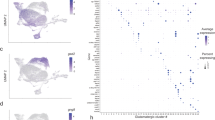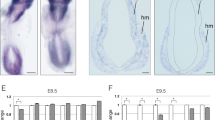Abstract
It is known that the NMDA-R NR1 subunit is needed for the receptor activity and that under hypoxia the evolution toward apoptosis or neuronal survival depends on the balance NR2A/NR2B subunits. This paper analyzes the effect of acute hypoxia on the above mentioned subunits mRNAs during development. The mean percentage of NR1+ neurons displayed the higher plasticity during development while the NR2A+ neurons the higher stability. Acute hypoxia increased the mean percentage of NR1+ and NR2B+ neurons at ED12 but only that of NR1+ neurons at ED18. Acute hypoxia increased the levels of expression of NR1 and NR2B mRNAs at ED12 without changes in the NR2A mRNA. During early stages there is a higher sensitivity to change the subunits mRNA levels under a hypoxic treatment. At ED12 acute hypoxia increased the probability of co-expression of the NR1–NR2A and NR1–NR2B subunits combinations, the level of NR1 and NR2B and the ratio NR2B/NR2A. These conditions facilitate the evolution towards apoptosis.





Similar content being viewed by others
References
Dingledine R, McBain CJ (1999) Glutamate and Aspartate. In: Siegel GJ, Agranoff BW, Albers RW, Fisher SK, Uhler MD (eds) Basic neurochemistry: molecular, cellular and medical aspects. Lippincott-Raven, Philadelphia, pp 315–333
Fonnum F (1984) Glutamate: a neurotransmitter in mammalian brain. J Neurochem 42:1–11
Choi DW (1988) Glutamate neurotoxicity and diseases of the nervous system. Neuron 1:623–634
Mukhin AG, Ivanova SA, Knoblach SM et al (1997) New in vitro model of traumatic neuronal injury: evaluation of secondary injury and glutamate receptor-mediated neurotoxicity. J Neurotrauma 13:651–663
Fukuda T, Wang H, Nakanishi H et al (1999) Novel non-apoptotic morphological changes in neurons of the mouse hippocampus following transient hypoxic-ischemia. Neurosci Res 33:49–55
Oo TF, Henchcliffe C, Burke RE (1995) Apoptosis in substantia nigra following developmental hypoxic-ischemic injury. Neurosci 69:893–901
Cataltepe O, Towfighi J, Vannucci RC (1996) Cerebrospinal fluid concentrations of glutamate and GABA during perinatal cerebral hypoxia-ischemia and seizures. Brain Res 709:326–330
Lombroso CT (1996) Neonatal seizures: a clinician’s overview. Brain Dev 18:1–28
Rego AC, Santos MS, Oliveiva CR (1996) Oxidative stress, hypoxia, and ischemia-like conditions increase the release of endogenous amino acids by distinct mechanisms in cultured retinal cells. J Neurochem 66:2506–2516
Saransaari P, Oja SS (1998) Release of endogenous glutamamte, aspartate, GABA, and taurine from hippocampal slices from adult and developing mice under cell-damaging conditions. Neurochem Res 23:563–570
Kim AH, Kerchner GA, Choi DW (2002) Blocking excitotoxicity. In: Marcoux FW, Choi DW (eds) CNS Neuroprotecction. Springer, New York, pp 3–36
Meldrum B (1985) Possible therapeutic applications of antagonists of excitatory amino acid neurotransmitters. Clin Sci 68:113–122
Lutz PL, Leone-Kabler SL (1995) Upregulation of the GABAA / benzodiazepine receptor during anoxia in the freshwater turtle brain. Am J Physiol 268:R1332–R1335
Ninomiya H, Taniguchi T, Kameyama M et al (1988) Increased binding of [3H]muscimol and [3H]flunitrazepam in the rat brain under hypoxia. J Neurochem 51:1111–1117
Onodera H, Sato G, Kogure K (1987) GABA and benzodiazepine receptors in the gerbil brain after transient ischemia: demonstration by quantitative receptor autoradiography. J Cereb Blood Flow Metab 7:82–88
Sher PK, Hu SX (1990) Increased glutamate uptake and glutamine synthetase activity in neuronal cell cultures surviving chronic hypoxia. Glia 3(5):350–357
Jensen FE, Applegate CD, Holtzman D et al (1991) Epileptogenic effect of hypoxia in the immature rodent brain. Ann Neurol 29:629–637
Fiszer de Plazas S, Rapacioli M, Rodríguez Gil DJ et al (2007) Acute hypoxia differentially affects the gamma-aminobutyric acid type A receptor alpha(1), alpha(2), beta(2), and gamma(2) subunit mRNA levels in the developing chick optic tectum: stage-dependent sensitivity. J Neurosci Res 85:3135–3144
Stephenson FA, Cousins SL, Kenny AV (2008) Assembly and forward trafficking of NMDA receptors. Mol Membr Biol 25:311–320
Cai Z, Rhodes PG (2001) Intrauterine hypoxia-ischemia alters expression of the NMDA receptor in the young rat brain. Neurochem Res 26:487–495
Kaur C, Sivakumar V, Ang LS et al (2006) Hypoxic damage to the periventricular white matter in neonatal brain: role of vascular endothelial growth factor, nitric oxide and excitotoxicity. J Neurochem 98:1200–1216
Kobayashi S, Millhorn DE (2000) Regulation of N-methyl-D-aspartate receptor expression and N-methyl-D-aspartate-induced cellular response during chronic hypoxia in differentiated rat PC12 cells. Neurosci 101:153–1162
Schmitt A, Fent M, Zink M et al (2007) Altered NMDA receptor expression and behavior following postnatal hypoxia: potential relevance to schizophrenia. J Neural Transm 114:239–248
Pozo Devoto VM, Chavez JC, Fiszer de Plazas S (2006) Acute hypoxia and programmed cell death in developing CNS: differential vulnerability of chick optic tectum layers. Neurosci 142:645–653
Moroyoshi K, Masu M, Ishii T et al (1991) Molecular cloning and characterization of rat NMDA receptor. Nature 354:31–37
Stephenson FA (2006) Structure and trafficking of NMDA and GABA-A receptors. Biochem Soc Trans 34:877–881
Monyer H, Burnashev N, Laurie DJ et al (1994) Developmental and regional expression in the rat brain and functional properties of four NMDA receptors. Neuron 12:529–540
Liu XB, Murria KD, Jones EG (2004) Switching of NMDA receptor 2A and 2B subunits at thalamic and cortical synapses during early postnatal development. J Neurosci 24:8885–8895
Zhou M, Baudry M (2006) Developmental changes in NMDA neurotoxicity reflect developmental changes in subunit composition of NMDA receptors. J Neurosci 26:2956–2963
Liu Y, Wong TP, Aarts M et al (2007) NMDA receptor subunits have differential roles in mediating excitotoxic neuronal death both in vitro and in vivo. J Neurosci 27:2846–2857
Rodríguez Gil DJ, Viapiano MS, Fiszer de Plazas S (2000) Acute hypoxic hypoxia transiently reduces GABA(A) binding site number in developing chick optic lobe. Dev Brain Res 124:67–72
Wisden W, Morris BJ, Hunt SP (1991) In situ hybridization with synthetic DNA probes. In: Chad J, Wheal M (eds) Molecular neurobiology. IRL Press, Oxford, pp 205–225
Rodríguez Gil DJ, Vacotto M, Rapacioli M et al (2005) Development and localisation of GABAA receptor a1, a2, b2 and c2 subunit mRNA in the chick optic tectum. J Neurosci Res 81:469–480
Scicolone G, Pereyra-Alfonso S, Brusco A et al (1995) Development of the laminated pattern of the chick tectum opticum. Int J Dev Neurosci 13:845–858
Vacotto M, Rodríguez Gil DJ, Mitridate de Novara A et al (2003) Differential and irreversible CNS ontogenic reduction in maximal MK-801 binding site number in the NMDA receptor after acute hypoxic hypoxia. Brain Res 976:202–208
Lipton P (1999) Ischemic cell death in brain neurons. Physiol Rev 79:1431–1568
Zanelli SA, Numagami Y, McGowan JE et al (1999) NMDA receptor-mediated calcium influx in cerebral cortical synaptosomes of the hypoxic guinea pig fetus. Neurochem Res 24:437–446
VanDongen AM, VanDongen HM (2004) Effects of mRNA untranslated regions on translational efficiency of NMDA receptor subunits. Neurosignals 13(4):194–206
Cui Y, Zhang J, Cai R et al (2009) Early auditory experience-induced composition/ratio changes of N-methyl-D-aspartate receptor subunit expression and effects of D-2-amino-5-phosphonovaleric acid chronic blockade in rat auditory cortex. J Neurosci Res 87(5):1123–1134
Rivera-Cervantes MC, Flores-Soto ME, Chaparro-Huerta V et al (2009) Changes in hippocampal NMDA-R subunit composition induced by exposure of neonatal rats to L-glutamate. Int J Dev Neurosci 27(2):197–204
Bolognani F, Perrone-Bizzozero NI (2008) RNA-protein interactions and control of mRNA stability in neurons. J Neurosci Res 86(3):481–489
Anji A, Kumari M (2006) A novel RNA binding protein that interacts with NMDA R1 mRNA: regulation by ethanol. Eur J Neurosci 23(9):2339–2350
Levy AP, Levy NS, Goldberg MA (1996) Post-transcriptional regulation of vascular endothelial growth factor by hypoxia. J Biol Chem 271:2746–2753
Li C, Browder W, Kao RL (1999) Early activation of transcription factor NF-jB during ischemia in perfused rat heart. Am J Physiol Heart Circ Physiol 276:543–552
McGary EC, Rondon IJ, Beckman BS (1997) Post-transcriptional regulation of erythropoietin mRNA stability by erythropoietin mRNA-binding protein. J Biol Chem 272:8628–8634
Zhang Y, Furuyama K, Kaneko K et al (2006) Hypoxia reduces the expression of heme oxygenase-2 in various types of human cell lines. A possible strategy for the maintenance of intracellular heme level. FEBS Lett 273:3136–3147
Zulueta JJ, Sawhney R, Kayyali U et al (2002) Modulation of inducible nitric oxide synthase by hypoxia in pulmonary artery endothelial cells. Am J Respir Cell Mol Biol 26:22–30
Acknowledgments
This work was supported by grants from Consejo Nacional de Investigaciones Científicas y Técnicas (CONICET, PIP 5410) and Agencia Nacional para la Promoción Científica y Tecnológica (FONCYT, PICT 38234).
Author information
Authors and Affiliations
Corresponding author
Rights and permissions
About this article
Cite this article
Vacotto, M., Rapacioli, M., Flores, V. et al. Acute Hypoxia Differentially Affects the NMDA Receptor NR1, NR2A and NR2B Subunit mRNA Levels in the Developing Chick Optic Tectum: Stage-Dependent Plasticity in the 2B–2A Ratio. Neurochem Res 35, 1609–1619 (2010). https://doi.org/10.1007/s11064-010-0221-4
Accepted:
Published:
Issue Date:
DOI: https://doi.org/10.1007/s11064-010-0221-4




